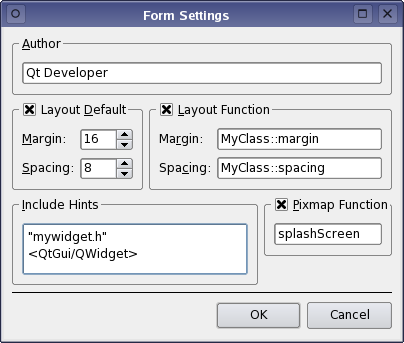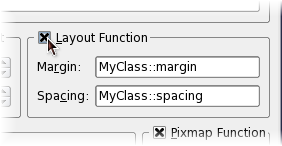- Accueil Actualités IT Pro
- Conception Cycle de vie du logiciel
- Java Plateforme et langage Java
- .NET Microsoft Framework .NET
- Dév. Web Développement Web et Webmarketing
- EDI Environnements de Développement Intégré
- Langages Langages de programmation applicatifs
- SGBD Systèmes de Gestion de Bases de Données
- Office Bureautique pour l'entreprise
- Solutions d'entreprise Autres logiciels pour l'entreprise
- Applications Applications logicielles
- Systèmes Logiciels et matériels systèmes
Customizing Qt Designer Forms
When saving a form in Qt Designer, it is stored as a UI file. Several form settings, for example the grid settings or the margin and spacing for the default layout, are stored along with the form's components. These settings are used when the uic generates the form's C++ code. For more information on how to use forms in your application, see the Using a Designer UI File in Your Application section. Modifying the Form SettingsTo modify the form settings, open the Form menu and select Form Settings... In the forms settings dialog you can specify the Author of the form. You can also alter the margin and spacing properties for the form's default layout (Layout Default). These default layout properties will be replaced by the corresponding Layout Function, if the function is specified, when uic generates code for the form. The form settings dialog lets you specify functions for both the margin and the spacing.
You can also specify the form's Include Hints; i.e., provide a list of the header files which will then be included in the form window's associated UI file. Header files may be local, i.e., relative to the project's directory, "mywidget.h", or global, i.e. part of Qt or the compilers standard libraries: <QtGui/QWidget>. Finally, you can specify the function used to load pixmaps into the form window (the Pixmap Function). [Previous: Using Stylesheets with Qt Designer] [Next: Using Custom Widgets with Qt Designer] |
| Cette page est une traduction d'une page de la documentation de Qt, écrite par Nokia Corporation and/or its subsidiary(-ies). Les éventuels problèmes résultant d'une mauvaise traduction ne sont pas imputables à Nokia. | Qt 4.8 | |
| Copyright © 2012 Developpez LLC. Tous droits réservés Developpez LLC. Aucune reproduction, même partielle, ne peut être faite de ce site et de l'ensemble de son contenu : textes, documents et images sans l'autorisation expresse de Developpez LLC. Sinon, vous encourez selon la loi jusqu'à 3 ans de prison et jusqu'à 300 000 E de dommages et intérêts. Cette page est déposée à la SACD. | ||
| Vous avez déniché une erreur ? Un bug ? Une redirection cassée ? Ou tout autre problème, quel qu'il soit ? Ou bien vous désirez participer à ce projet de traduction ? N'hésitez pas à nous contacter ou par MP ! | ||
Copyright © 2000-2012 - www.developpez.com





















